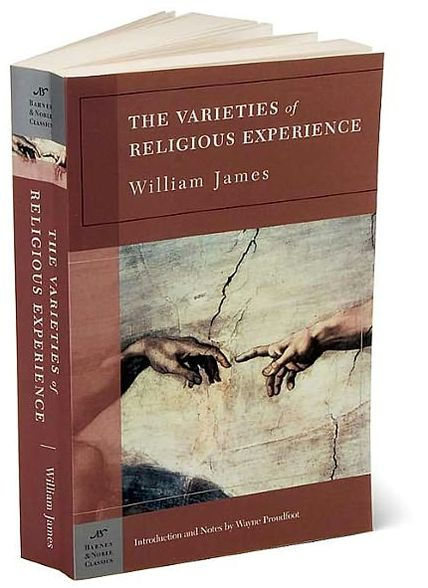- New introductions commissioned from today's top writers and scholars
- Biographies of the authors
- Chronologies of contemporary historical, biographical, and cultural events
- Footnotes and endnotes
- Selective discussions of imitations, parodies, poems, books, plays, paintings, operas, statuary, and films inspired by the work
- Comments by other famous authors
- Study questions to challenge the reader's viewpoints and expectations
- Bibliographies for further reading
- Indices & Glossaries, when appropriate
Acclaimed as one of the greatest works of nonfiction published in the twentieth century, William James’s The Varieties of Religious Experience was revolutionary in its view of religious life as centered not within the Church but solely within “the feelings, acts, and experiences of individual men in their solitude.”
Using the language of psychology, James tries to explain religious phenomena—such as conversion, repentance, mysticism, and saintliness—as psychic energy that arises from the unconscious mind in times of trouble. To support his theories, James turns to the autobiographical writings of a wide variety of mystics and writers, including Walt Whitman, Martin Luther, Voltaire, Emerson, and Tolstoy. The result is a colorful and wide-ranging collection of recorded experiences that James compares, categorizes, and analyzes. Many of his categories—including the sick soul, the divided self, and healthy-mindedness—have become standard in the study of religions.
Exquisitely written, The Varieties of Religious Experience has had a profound influence on modern spiritual thought, including the psychology of religion and recovery programs such as Alcoholics Anonymous.
Wayne Proudfoot is Professor of Religion at Columbia University, specializing in the philosophy of religion. He has published Religious Experience, as well as articles on William James, Charles Sanders Peirce, and American Protestant thought.
- New introductions commissioned from today's top writers and scholars
- Biographies of the authors
- Chronologies of contemporary historical, biographical, and cultural events
- Footnotes and endnotes
- Selective discussions of imitations, parodies, poems, books, plays, paintings, operas, statuary, and films inspired by the work
- Comments by other famous authors
- Study questions to challenge the reader's viewpoints and expectations
- Bibliographies for further reading
- Indices & Glossaries, when appropriate
Acclaimed as one of the greatest works of nonfiction published in the twentieth century, William James’s The Varieties of Religious Experience was revolutionary in its view of religious life as centered not within the Church but solely within “the feelings, acts, and experiences of individual men in their solitude.”
Using the language of psychology, James tries to explain religious phenomena—such as conversion, repentance, mysticism, and saintliness—as psychic energy that arises from the unconscious mind in times of trouble. To support his theories, James turns to the autobiographical writings of a wide variety of mystics and writers, including Walt Whitman, Martin Luther, Voltaire, Emerson, and Tolstoy. The result is a colorful and wide-ranging collection of recorded experiences that James compares, categorizes, and analyzes. Many of his categories—including the sick soul, the divided self, and healthy-mindedness—have become standard in the study of religions.
Exquisitely written, The Varieties of Religious Experience has had a profound influence on modern spiritual thought, including the psychology of religion and recovery programs such as Alcoholics Anonymous.
Wayne Proudfoot is Professor of Religion at Columbia University, specializing in the philosophy of religion. He has published Religious Experience, as well as articles on William James, Charles Sanders Peirce, and American Protestant thought.

The Varieties of Religious Experience (Barnes & Noble Classics Series)
512
The Varieties of Religious Experience (Barnes & Noble Classics Series)
512Related collections and offers

Product Details
| ISBN-13: | 9781593080723 |
|---|---|
| Publisher: | Barnes & Noble |
| Publication date: | 02/01/2004 |
| Series: | Barnes & Noble Classics Series |
| Pages: | 512 |
| Sales rank: | 66,456 |
| Product dimensions: | 5.18(w) x 8.00(h) x 1.28(d) |
About the Author
Customer Reviews
Explore More Items
Eliot Rosewater—drunk, volunteer fireman, and President of the fabulously rich Rosewater Foundation—is about to attempt a noble experiment with human nature . . . with a little help from
Deadeye Dick is Kurt Vonnegut’s funny, chillingly satirical look at the death of innocence. Amid a true Vonnegutian
There were no prisons, no slums, no insane asylums, no cripples, no poverty, no wars.
All diseases were conquered. So was old age.
Death, barring accidents, was an
Etched against the background of a dying rural society, Tess of the d'Urbervilles was Thomas Hardy's 'bestseller,' and Tess Durbeyfield remains his most striking and tragic heroine. Of all the
Etched against the background of a dying rural society, Tess of the d'Urbervilles was Thomas Hardy's 'bestseller,' and Tess Durbeyfield remains his most striking and tragic heroine. Of all the
In "Confession" Tolstoy poses the question: Is there any meaning in my life that will not be destroyed by my death?
In 1879 the fifty-year-old author of "War and Peace" and "Anna Karenina" came to
"Sweeping, erudite, sharply argued, and fun to
In this Pulitzer Prize finalist and national bestseller, one of the world's leading cognitive scientists
A provocative history of violence—from the New York



